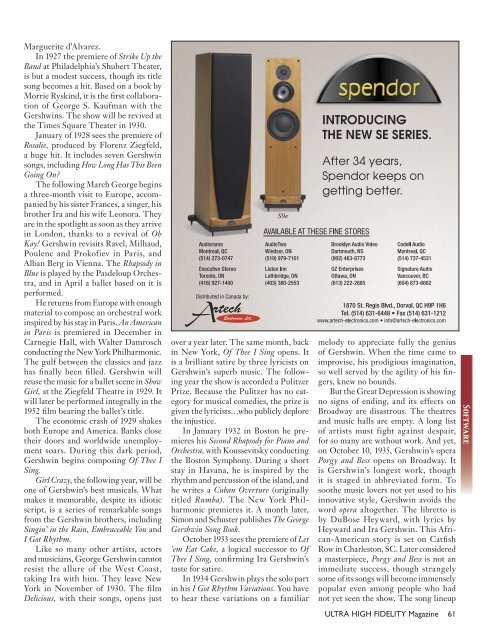UHF No 70 (Net).indd - Ultra High Fidelity Magazine
UHF No 70 (Net).indd - Ultra High Fidelity Magazine
UHF No 70 (Net).indd - Ultra High Fidelity Magazine
Create successful ePaper yourself
Turn your PDF publications into a flip-book with our unique Google optimized e-Paper software.
Marguerite d’Alvarez.<br />
In 1927 the premiere of Strike Up the<br />
Band at Philadelphia’s Shubert Theater,<br />
is but a modest success, though its title<br />
song becomes a hit. Based on a book by<br />
Morrie Ryskind, it is the fi rst collaboration<br />
of George S. Kaufman with the<br />
Gershwins. The show will be revived at<br />
the Times Square Theater in 1930.<br />
January of 1928 sees the premiere of<br />
Rosalie, produced by Florenz Ziegfeld,<br />
a huge hit. It includes seven Gershwin<br />
songs, including How Long Has This Been<br />
Going On?<br />
The following March George begins<br />
a three-month visit to Europe, accompanied<br />
by his sister Frances, a singer, his<br />
brother Ira and his wife Leonora. They<br />
are in the spotlight as soon as they arrive<br />
in London, thanks to a revival of Oh<br />
Kay! Gershwin revisits Ravel, Milhaud,<br />
Poulenc and Prokofiev in Paris, and<br />
Alban Berg in Vienna. The Rhapsody in<br />
Blue is played by the Pasdeloup Orchestra,<br />
and in April a ballet based on it is<br />
performed.<br />
He returns from Europe with enough<br />
material to compose an orchestral work<br />
inspired by his stay in Paris. An American<br />
in Paris is premiered in December in<br />
Carnegie Hall, with Walter Damrosch<br />
conducting the New York Philharmonic.<br />
The gulf between the classics and jazz<br />
has fi nally been fi lled. Gershwin will<br />
reuse the music for a ballet scene in Show<br />
Girl, at the Ziegfeld Theatre in 1929. It<br />
will later be performed integrally in the<br />
1952 fi lm bearing the ballet’s title.<br />
The economic crash of 1929 shakes<br />
both Europe and America. Banks close<br />
their doors and worldwide unemployment<br />
soars. During this dark period,<br />
Gershwin begins composing Of Thee I<br />
Sing.<br />
Girl Crazy, the following year, will be<br />
one of Gershwin’s best musicals. What<br />
makes it memorable, despite its idiotic<br />
script, is a series of remarkable songs<br />
from the Gershwin brothers, including<br />
Singin’ in the Rain, Embraceable You and<br />
I Got Rhythm.<br />
Like so many other artists, actors<br />
and musicians, George Gershwin cannot<br />
resist the allure of the West Coast,<br />
taking Ira with him. They leave New<br />
York in <strong>No</strong>vember of 1930. The fi lm<br />
Delicious, with their songs, opens just<br />
over a year later. The same month, back<br />
in New York, Of Thee I Sing opens. It<br />
is a brilliant satire by three lyricists on<br />
Gershwin’s superb music. The following<br />
year the show is accorded a Pulitzer<br />
Prize. Because the Pulitzer has no category<br />
for musical comedies, the prize is<br />
given the lyricists…who publicly deplore<br />
the injustice.<br />
In January 1932 in Boston he premieres<br />
his Second Rhapsody for Piano and<br />
Orchestra, with Koussevitsky conducting<br />
the Boston Symphony. During a short<br />
stay in Havana, he is inspired by the<br />
rhythm and percussion of the island, and<br />
he writes a Cuban Overture (originally<br />
titled Rumba). The New York Philharmonic<br />
premieres it. A month later,<br />
Simon and Schuster publishes The George<br />
Gershwin Song Book.<br />
October 1933 sees the premiere of Let<br />
’em Eat Cake, a logical successor to Of<br />
Thee I Sing, confi rming Ira Gershwin’s<br />
taste for satire.<br />
In 1934 Gershwin plays the solo part<br />
in his I Got Rhythm Variations. You have<br />
to hear these variations on a familiar<br />
melody to appreciate fully the genius<br />
of Gershwin. When the time came to<br />
improvise, his prodigious imagination,<br />
so well served by the agility of his fi ngers,<br />
knew no bounds.<br />
But the Great Depression is showing<br />
no signs of ending, and its effects on<br />
Broadway are disastrous. The theatres<br />
and music halls are empty. A long list<br />
of artists must fight against despair,<br />
for so many are without work. And yet,<br />
on October 10, 1935, Gershwin’s opera<br />
Porgy and Bess opens on Broadway. It<br />
is Gershwin’s longest work, though<br />
it is staged in abbreviated form. To<br />
soothe music lovers not yet used to his<br />
innovative style, Gershwin avoids the<br />
word opera altogether. The libretto is<br />
by DuBose Heyward, with lyrics by<br />
Heyward and Ira Gershwin. This African-American<br />
story is set on Catfi sh<br />
Row in Charleston, SC. Later considered<br />
a masterpiece, Porgy and Bess is not an<br />
immediate success, though strangely<br />
some of its songs will become immensely<br />
popular even among people who had<br />
not yet seen the show. The song lineup<br />
ULTRA HIGH FIDELITY <strong>Magazine</strong> 61<br />
Software

















